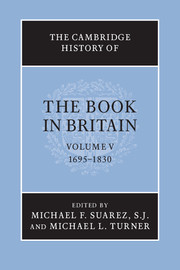Book contents
- Frontmatter
- Introduction
- PART I THE QUANTITY AND NATURE OF PRINTED MATTER
- PART II ECONOMIC, LEGAL AND CULTURAL CONTEXTS
- PART III THE TECHNOLOGIES AND AESTHETICS OF BOOK PRODUCTION
- 7 The technologies of printing
- 8 The industrialization of the paper trade
- 9 A year’s work in the London printing house of the Bowyers
- 10 Book illustration and the world of prints
- 11 The morphology of the page
- 12 Bookbinding in the eighteenth century
- PART IV THE BOOK TRADE AND ITS MARKETS
- V BOOKS AND THEIR READERS
- Abbreviations used in bibliography
- Bibliography
- Index
- Frontispiece
- Plate section
- References
7 - The technologies of printing
from PART III - THE TECHNOLOGIES AND AESTHETICS OF BOOK PRODUCTION
Published online by Cambridge University Press: 28 September 2010
- Frontmatter
- Introduction
- PART I THE QUANTITY AND NATURE OF PRINTED MATTER
- PART II ECONOMIC, LEGAL AND CULTURAL CONTEXTS
- PART III THE TECHNOLOGIES AND AESTHETICS OF BOOK PRODUCTION
- 7 The technologies of printing
- 8 The industrialization of the paper trade
- 9 A year’s work in the London printing house of the Bowyers
- 10 Book illustration and the world of prints
- 11 The morphology of the page
- 12 Bookbinding in the eighteenth century
- PART IV THE BOOK TRADE AND ITS MARKETS
- V BOOKS AND THEIR READERS
- Abbreviations used in bibliography
- Bibliography
- Index
- Frontispiece
- Plate section
- References
Summary
Introduction
The technique of printing and its ancillary processes is more certainly known for the eighteenth century than for any previous period. This is due above all to the publication of a series of technical manuals, of which the outstanding example is Joseph Moxon’s Mechanick exercises of 1683–4, but also because many of the processes of the ‘hand-press period’ survived in common use in the printing industry until the last quarter of the twentieth century and were familiar at first-hand to historians of the book, some of whom created their own ‘laboratory’ or ‘bibliographical’ presses in order to replicate the conditions in which early texts had been produced. The correction of composed type and the assembly of lines into pages is one example, but a fundamental one, of this continuity. Although in Britain after 1900 books were increasingly set on the Monotype machine, its product consisted of justified lines of separate type, and although the first proofs were made on slips from type in long galleys (a practice that did not become common until after the period covered by this volume), type was still corrected, letter by letter, by a compositor using a bodkin, and was then made up into pages by hand, and imposed in the manner described by Moxon and his successors.
This long continuity was broken with the disuse of printing from relief type during the last quarter of the twentieth century, leaving the historian increasingly dependent upon other sources of information. This needs to be borne in mind because it can sometimes be discerned that technical literature gives a partial or even a misleading account of contemporary technology. Moxon’s one-sided promotion of the ‘new-fashioned’ printing press is one example. Disagreements about the details of the introduction of mechanized printing given in British and German sources provide another. Where inventories of printing offices and detailed records of production have been located and studied, they may give a more reliable picture of the nature of the materials that were available at a given period and the way in which they were used. McKenzie’s incomparably detailed study of the unpredictable realities of the working of specific printing offices needs to be supplemented with many more case studies, especially from the later period.
Keywords
- Type
- Chapter
- Information
- The Cambridge History of the Book in Britain , pp. 161 - 199Publisher: Cambridge University PressPrint publication year: 2009
References
- 5
- Cited by

